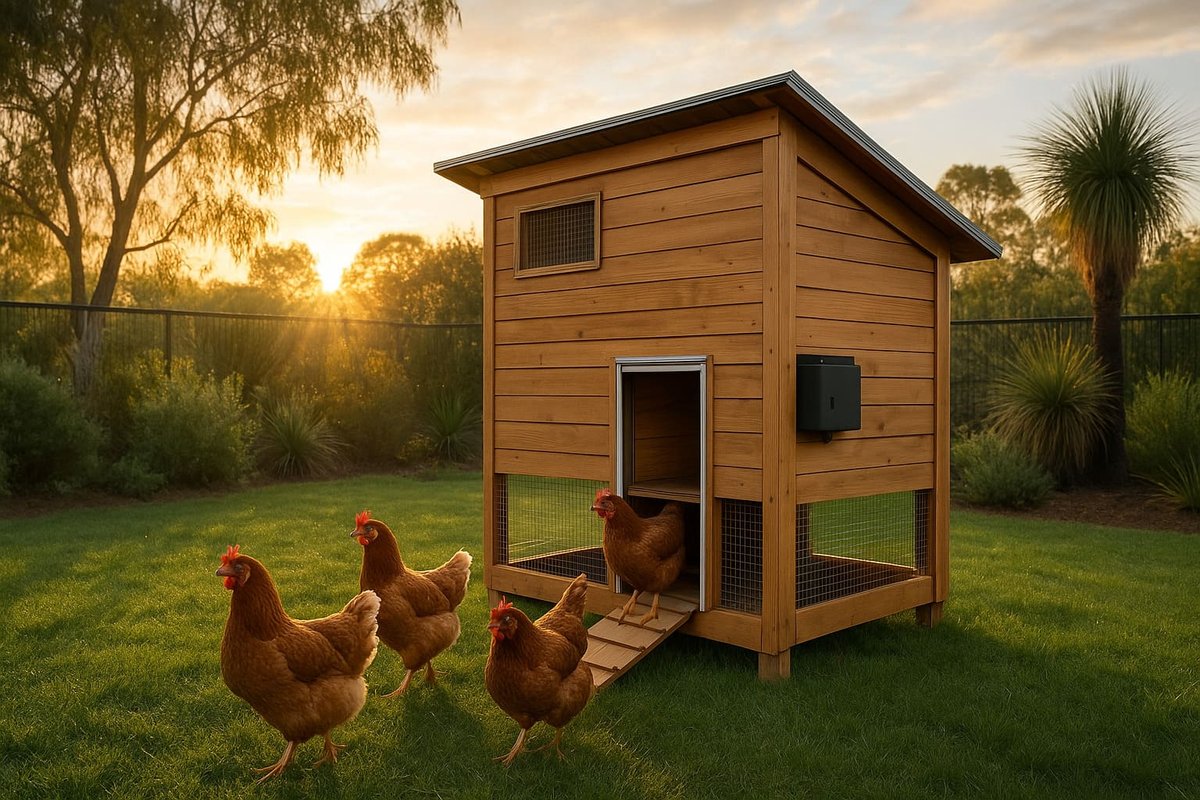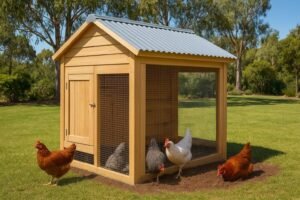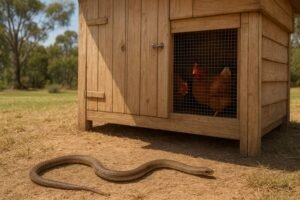As experienced backyard chicken keepers with over a decade of combined experience—from suburban Sydney backyards to rural Queensland properties—we’ve tested our fair share of gear. We know what survives an Aussie climate and what doesn’t. This guide is based on our real-world testing and research to help you find the right solution for your flock (or to help you decide how many chickens you need for a family of 4).
Why Automatic Chicken Coop Doors Are Essential for Australian Backyard Chicken Keepers
You know how frustrating it is when you’re running late from work, stuck in traffic, and all you can think about is, “Are my chooks locked up?” Or that 5 AM weekend wake-up call, just to let them out. For Australian backyard chicken keepers, an automatic chicken coop door opener isn’t a luxury anymore; it’s a game-changer.
When you’re choosing the best automatic chicken coop doors for the Australian market, you’re buying two things: safety and freedom. Our unique Australian climate challenges—from scorching heatwaves (here’s what to feed chickens during a heatwave) to sudden frosts in some regions—demand gear that’s tough. More importantly, we have relentless predators. A flimsy door is an open invitation for a fox, quoll, or even a determined snake.
We’ve found that a reliable automatic chicken coop door opener provides incredible peace of mind. It ensures your flock is protected with a consistent routine, even if you’re not there. Chickens are creatures of habit; they thrive on a predictable schedule, which reduces flock stress and can even improve egg production. This guide will walk you through everything you need to know, from power sources to predator protection, to make the best choice for your backyard flock.
That’s the ‘why’—it’s about security for your chooks and sanity for you. Now, let’s get into the ‘what’ and ‘how’ to look for when you’re ready to buy.
How to Choose the Best Automatic Chicken Coop Door Opener for Your Needs
Picking the right door can feel overwhelming. Do you need solar? What’s the difference between a sensor and a timer? And what’s an “auto-lock”? Let’s break down the most important features you need to consider.
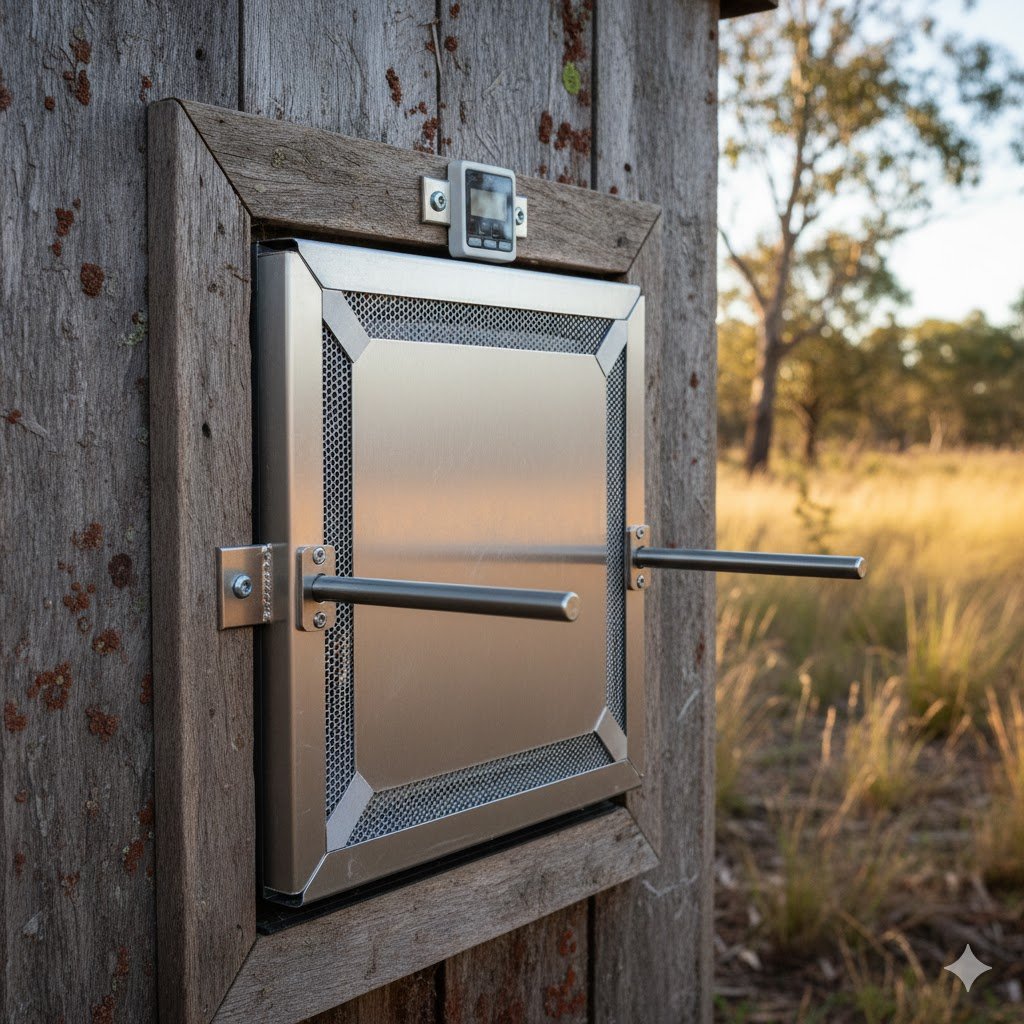
Power Source Options: Solar, Battery & Electric Automatic Doors
How your door gets its ‘juice’ is a critical choice, especially in Australia.
- Battery-Operated: This is the most common and simplest option. Most doors run for 6-12 months on a set of standard batteries (like AAs or Ds). However, battery life varies significantly by brand and usage. For example, some premium models like the Safe Coop claim their batteries can last for around two years, so it’s worth checking the manufacturer’s specifications.
- Electric Plug-In: These are less common, as most coops don’t have a convenient power point nearby. While reliable, they’re useless during a power outage unless you have a battery backup, which many don’t.
- Solar-Powered: For Australian conditions—especially rural or off-grid—solar automatic chicken doors are usually the smartest long-term investment. They use a small solar panel to charge an internal battery, meaning you get the reliability of battery power without ever having to replace them. Given our abundant sunshine, a solar automatic chicken door in Australia is a perfect fit, and you can even add solar power to your chicken coop as a wider DIY project.
Light Sensor vs. Timer: Understanding Automatic Door Functionality
This feature controls when your door opens and closes.
- Light Sensor: This is the “set it and forget it” option. A sensor detects the level of daylight, opening the door at dawn and closing it at dusk. It’s fantastic because it automatically adjusts with the seasons. The minor downside? A very dark, stormy afternoon or a poorly placed security light could trick it.
- Timer Functionality: This gives you precise control. You set the exact time you want the door to open (e.g., 7:00 AM) and close (e.g., 8:00 PM). This is great if you have a fixed routine or want to keep your chooks in a bit later in the morning (so they don’t wake the neighbours!).
- Dual Functionality: The best models offer both. You can set a timer but also use the light sensor as a backup. For example, “Close at 8:00 PM, or at dusk, whichever comes first.” This combination gives you complete flexibility and is what we recommend.
| Feature | Light Sensor | Timer | Dual Functionality |
|---|---|---|---|
| How it Works | Detects ambient light (dawn/dusk) | Opens/closes at a specific time | Uses both sensor and timer |
| Pros | Adjusts automatically with seasons | Precise, predictable control | Maximum flexibility & safety |
| Cons | Can be fooled by storms/lights | Needs manual adjustment (e.g., daylight saving) | Can be slightly more complex to set up |
| Best For | Keepers who want a natural routine | Keepers with a strict schedule | Everyone—it’s the best of both worlds |
Security Features: Predator-Proof Automatic Chicken Doors
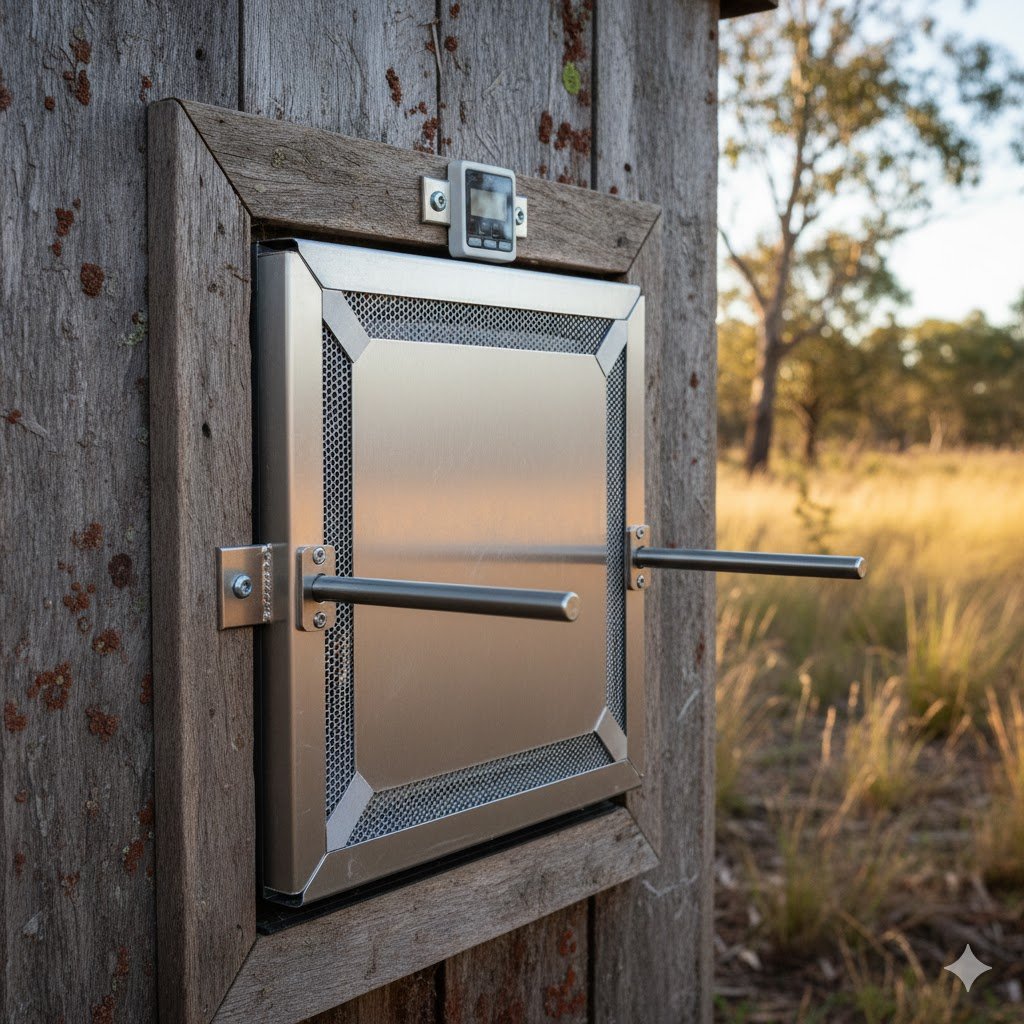
A coop door’s number one job is security. In Australia, where foxes and snakes are real threats, look for doors that are made of metal or thick, heavy-duty polycarbonate. Flimsy plastic or thin wood won’t cut it.
The best-in-class models feature an auto-locking mechanism. This means when the door is fully closed, locking bolts or wings engage, making it impossible for a predator to lift the door from the outside. Foxes are smart; they can learn to use their noses or paws to lift a simple sliding door. An auto-lock defeats this entirely. This is a non-negotiable feature for high-predator areas, and it’s a key part of an overall predator-proof chicken coop design.
Safety Sensors: Anti-Pinch Protection for Your Flock
This is a critical feature that often gets overlooked. What happens if a slow chook is halfway through the door when it starts to close? A good door will have a safety sensor (either detecting resistance or using an infrared beam). If it detects an obstruction (like your chicken), it will stop, and usually re-open, before trying to close again. Cheaper models without this feature can potentially trap or injure a bird.
Build Material: Metal vs. Plastic vs. Wood
- Metal (Aluminium): This is our top choice. It’s lightweight (so the motor doesn’t struggle), won’t warp or rot, and is completely predator-proof.
- UV-Stabilised Plastic/Polycarbonate: High-quality, thick plastic is also a great option. The key is “UV-stabilised”—our harsh Aussie sun will make cheap plastic brittle and cracked within a year. Brands like Omlet use this very effectively.
- Wood: We generally advise against wooden doors for automatic openers. They absorb moisture, swell, and warp, which causes them to jam in the runners.
Weather Resistance for Australian Climates
Your door will be exposed to everything the Aussie climate throws at it. It needs to be weather-resistant. Look for components made from UV-stabilised materials so they don’t crack and perish after one summer.
Check for an IP (Ingress Protection) rating, which tells you how well it’s sealed against dust and water, and proper chicken coop ventilation requirements also play a role in handling climate. More importantly, check the temperature operating range. As a benchmark, the Safe Coop automatic chicken coop door has been designed for all Australian climates. The temperature operating range is -20.0°C to +65.0°C, which covers everything from a frosty Tassie morning to a scorching Pilbara afternoon. Handling moisture is also key to keep your chicken coop dry.
Installation Ease & Compatibility
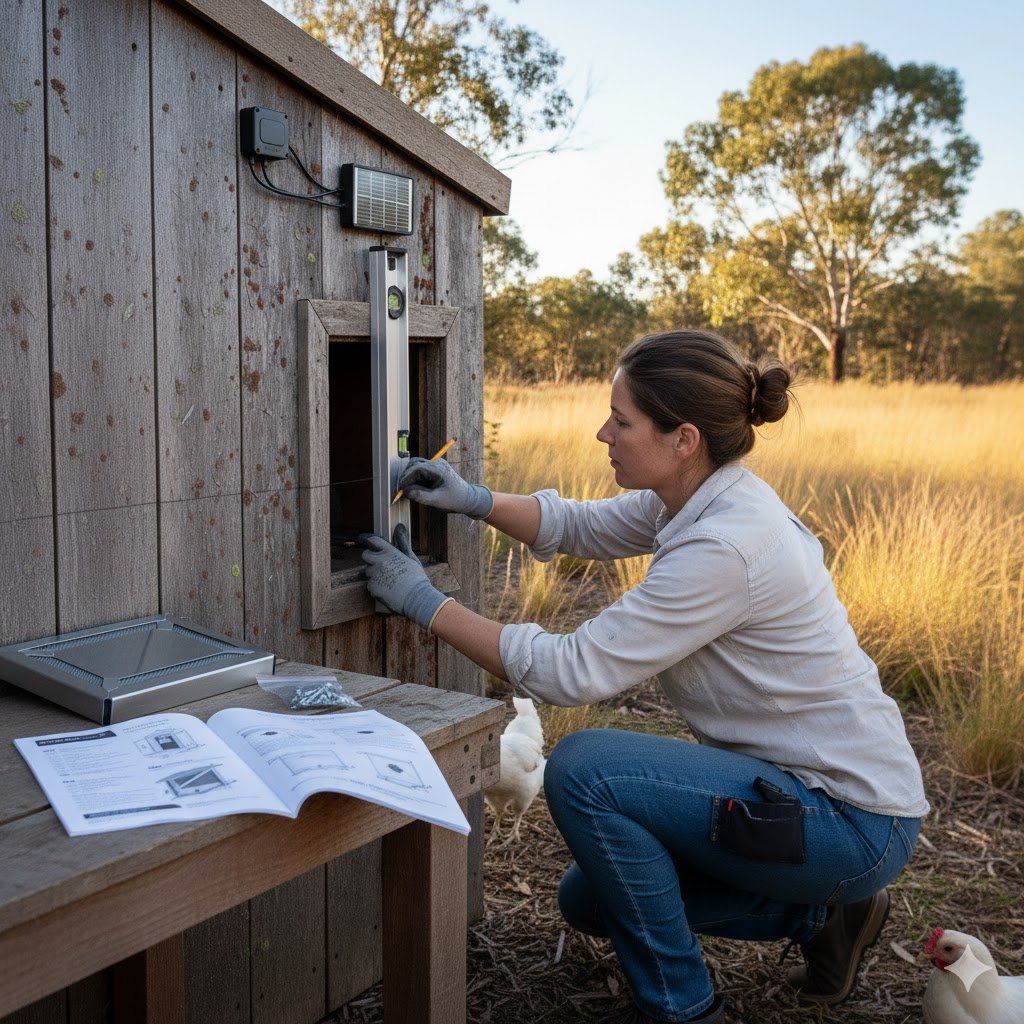
Most automatic doors are designed to be DIY-friendly. They usually just screw onto the outside or inside of your coop wall. Before you buy, check two things:
- Compatibility: Will it fit your coop? Most doors are designed for standard timber coops, but can be fitted to metal or plastic ones (like Omlet coops) with the right attachments.
- Size: Measure your existing pop-hole. The standard size for a chicken door is about 32cm high and 25cm wide, which is fine for most breeds, though it’s always good to consider how much space chickens really need. If you have very large birds, like Brahmas, Jersey Giants, or even Buff Orpingtons, you may need to search for a large automatic chicken coop door.
Choosing the right door comes down to those key features: a reliable power source, a smart sensor, and rock-solid security. But even the best tech can have a hiccup. Let’s look at the most common problems and how to fix them.
What Are Common Problems with Auto Coop Doors? Troubleshooting Guide
While modern auto-doors are very reliable, they aren’t perfect. But don’t worry—we’ve found that most of the common problems are simple, 5-minute fixes. While bigger issues like a motor or circuit board failure are rarer, they can happen, and we’ll cover those, too.
Door Won’t Open or Close: Power & Sensor Issues
This is the number one issue, and 99% of the time it’s simple:
- Check the Batteries: This is the first step. They’re dead.
- Clean the Sensor: A bit of mud, a spiderweb, or dust on the light sensor can stop it from working.
- Check for Obstructions: A piece of bedding, a clump of mud, or even a stubborn chook can block the door. Modern doors have a safety sensor that stops them from closing on a chicken, but this also means a small obstruction can stop them from closing at all. Clear the tracks!
- Door Weight: The most common technical issue encountered is people using doors that are too light (if you’ve just bought the opener mechanism). The motor relies on gravity, so the door needs some heft.
- Winter Sun: In winter, the sun is lower in the sky, causing issues with light sensors if they are in shadow for most of the day. You may need to adjust the sensor’s sensitivity.
“My Chickens Are Locked Out!” (User Error)
This is a common panic! It’s one of the mistakes every first-time chicken keeper makes, but it’s almost always a calibration issue. Your chooks have a set routine, but your door’s sensor or timer doesn’t know it.
- If using a timer: You’ve set the close time too early. Watch your flock for a few nights and see when the last chicken naturally goes to bed. Set the timer for 15-20 minutes after that.
- If using a sensor: The light sensitivity might be set too high (closing when it’s still too light). Most doors have a dial or setting to adjust this. Tweak it so it closes in darker conditions.
Door Freezing in Cold Weather
This is a rare problem in most of Australia, but for keepers in alpine regions or southern states, it’s a possibility. Ice can build up in the tracks and freeze the door shut. If you’re concerned, look for a model with a powerful motor and simple runners. With some models, the auto-locking mechanism can be easily disengaged using a dial on the door if freezing is a constant issue.
Wiring Faults & Connection Problems
If you have a solar-powered model or one with an external sensor, a wire could come loose. We’ve seen occasional ‘wiring fault’ errors that can be fixed by disconnecting and reconnecting the wire. Ensure all connections are tight and protected from rain.
Motor Running But Door Not Moving
You can hear the motor whirring, but nothing’s happening. This usually means the string or cord has snapped or come untied, or the gears are jammed. It’s usually a simple fix of re-threading the cord.
WiFi & Timer Synchronization Issues
For smart doors, the most common issue is losing connection to your home WiFi. For timer-based doors, don’t forget to adjust them twice a year for daylight savings!
See? Most issues are easily sorted. A little troubleshooting is a small price to pay for a door that’s going to be working hard for you, year after year. (And if you’re ever troubleshooting your birds, not just your door, here’s when to call the vet for a backyard chicken). That brings us to our next question: just how long will it last?
Automatic Chicken Door Lifespan: Durability & Maintenance in Australia
A good quality automatic chicken door should last 5-10 years, sometimes longer. A cheap, unbranded one from eBay might not last a single season.
The lifespan and durability depend on:
- Build Quality: Metal and high-grade, UV-stabilised plastics will always outlast cheap, brittle plastic.
- Climate: Our harsh Australian sun is the biggest killer. UV exposure will destroy untreated plastic. For coastal areas, salt air can corrode cheap metal components.
- Maintenance: They are very low-maintenance, but not no-maintenance. You’ll need to change the batteries (unless solar) and occasionally wipe mud from the runners to keep it running smoothly, as part of your regular coop maintenance, which also includes checking the best flooring for your chicken coop.
What Parts Fail First?
From our experience, the parts that take the most wear are:
- The Lift Cord: On models that use one, the string can fray after several years of daily use. This is a cheap and easy part to replace.
- The Motor: After 5-10 years (thousands of cycles), the motor can eventually wear out. This is why buying from a brand that sells replacement parts is so important.
- The Electronics: A very close lightning strike or constant moisture (if poorly installed) can fry the circuit board. This is rare in quality, well-sealed units.
The Value of a Good Warranty
Don’t overlook the warranty. A 1-year warranty is standard, but a 2 or 3-year warranty shows real confidence from the manufacturer. It means they’ve used quality components (motor, circuit board, weather-sealing) and are willing to stand by them. It’s a strong signal of a product’s long-term durability.
A long-lasting door is a great investment. But what happens during those wild Aussie storms when the power grid goes down? Will your investment still protect your flock?
Power Outage Protection: How Automatic Chicken Doors Keep Your Flock Safe
What happens during a blackout? It’s a valid concern, but most doors are designed to handle it.
Battery Backup Systems in Automatic Doors
The vast majority of doors (including solar ones) run on battery power. An electric plug-in model is the only one affected by a power outage, and good ones will have an internal backup battery that takes over. Because your standard auto-door runs on AAs or Ds, a blackout means nothing to it.
Manual Override Features
Any good door must have a manual override. This is usually just a button you can press on the controller to open or close the door by hand, regardless of the timer or sensor settings. This is essential for testing, for handling a power outage (if you have a plug-in model), or if you just need to lock the chooks away early.
Solar Doors: Built-In Redundancy
This is why solar-powered models are so good. They are, by design, off-grid. The solar panel charges an internal battery, which can typically run the door for weeks, if not months, without a single ray of sun. For Australian conditions—especially rural or off-grid—solar powered automatic chicken doors are usually the smartest long-term investment.
Plug-in Models and UPS Options
If you do have a plug-in model (perhaps in a shed with mains power), you can still protect it. We recommend plugging the door into a small, cheap Uninterruptible Power Supply (UPS)—the same kind you’d use for a computer. It will keep the door powered for days.
It’s clear that power loss isn’t a major worry for most models. So, are there any real downsides? To give you the full, honest picture, let’s talk about them.
What Are the Disadvantages of Automatic Doors? An Honest Assessment
To give you the full picture, let’s be honest about the drawbacks.
- Initial Cost: A good, reliable door is an investment. It will cost more than a simple manual door.
- Maintenance: While minimal, you still need to check batteries and clean the tracks.
- Potential for Failure: Like any technology, it can fail. The motor can die, the sensor can get blocked. This is why buying a quality product is so important. While cheap automatic chicken doors claim to offer great benefits at a bargain price, they often result in devastating consequences for you and your flock.
- False Sense of Security: An auto-door can make you complacent. You should still do a quick visual check on your flock each night, which we’ll cover below.
Flock Behaviour: The ‘Last Chook Out’ Problem
This is a real-world issue we’ve seen. You’ll have one stubborn hen who likes to stay out 10 minutes later than everyone else. If your timer is too aggressive, she’ll get locked out. This is why we recommend setting the timer for after you’ve observed the last chook going to bed, or using a light sensor, which they naturally follow.
Why You Still Need to Do a Daily ‘Headcount’
Your automatic door is a tool, not a substitute for good animal husbandry, as outlined in the RSPCA’s general care guidelines. It’s crucial that you still lay eyes on your flock at least once a day. A quick ‘headcount’ in the evening (even just peering through a window) ensures no one has been locked out, and that no one is sick (it’s a good time for a daily chicken health check), injured, or broody in a hidden spot.
So, there are a few things to keep in mind. But these are manageable. It’s not about the door meeting some arbitrary “standard,” but about it meeting the real-world rules of your local area.
Australian Standards for Automatic Chicken Doors: What You Need to Know
You might see references to various Australian Standards like AS1428 or AS2293. Let’s clear this up: there is no single Australian Standard specifically for chicken coop doors.
Those standards you see mentioned apply to human buildings, not chicken coops.
- What is AS1428 in Australian Standards? This relates to building design for access and mobility (e.g., wheelchair ramps). AS1428.1 specifies the maximum force required to open doors, which has zero relevance to a chook door.
- What is the AS2293 Standard in Australia? This is for emergency lighting and exit signs. AS2293 guides emergency lighting… requiring battery backup, but for human escape routes, not chicken coops.
- What are AS2047 and AS1288 Standards? AS 2047 is the mandatory standard for windows/doors in external walls of a house. Again, not relevant.
- What is the AS1851 Standard in Australia? This is a fire safety standard for maintaining fire protection systems.
- What is the Australian Standard AS4024? This is a set of standards for machine safety.
Actual Regulations for Backyard Chicken Coops in Australia
The real rules that matter are your local council regulations. These vary by state and council, but they all generally say the same thing: your coop must be secure.
- RSPCA guidance states: “Lock the chickens in their coop at night, even if they are free range during the day**.”
- Most council rules state: “All openings (including doors and windows) should be secured against predators such as foxes or cats.”
An automatic door helps you comply with this guidance perfectly, but the door itself isn’t regulated by a specific “AS” standard.
So, if there’s no official standard, are they just a ‘nice-to-have’ gimmick? Or are they genuinely a good idea for the average Aussie keeper? Let’s weigh it all up.
Are Automatic Chicken Doors Good? Pros, Cons & Real-World Performance
So, after all that, are automatic chicken doors good? Our verdict: Yes, absolutely. Especially for the Australian lifestyle.
Benefits of Automatic Chicken Doors
- Time Savings: No more rushing home or getting up at dawn.
- Predator Protection: Consistent, secure locking every single night.
- Flock Routine: Chickens thrive on routine, which reduces flock stress and can even improve egg production (which can also be supported with the best chicken treats for egg-laying).
- Travel Freedom: You can go away for a weekend without needing to rope in a neighbour.
- Peace of Mind: Knowing your chooks are safe and sound.
When Automatic Doors Make Sense
- You’re a busy owner who works late or travels, or perhaps a new keeper starting with one of the easiest chicken breeds for beginners.
- You live in an area with high predator risk (which is most of Australia).
- You have mobility issues that make the daily trip to the coop difficult.
- You just want that weekend sleep-in!
When Manual Doors Might Be Better
- You have a very small, secure setup and enjoy the daily routine.
- You are on an extremely tight budget (though we’d argue saving for a good one is worth it).
The Cost-Benefit & Time-Saving Verdict
Let’s say a good door costs $250. It seems like a lot, especially when added to the cost to raise chickens for the first year. But now, let’s do the maths.
- Time: If it saves you 10 minutes every day (5 in the morning, 5 at night), that’s 3,650 minutes, or over 60 hours a year. What’s 60 hours of your time worth?
- Security: How much would it cost to replace your flock? Not just the money, but the emotional cost of finding your chooks have been taken by a fox. When you look at it that way, a $250 door that lasts 5-10 years is one of the best investments you can make.
Real-World Performance in Australian Conditions
In our testing, modern, well-built doors handle Aussie conditions just fine. For Australian conditions—especially rural or off-grid—solar powered automatic chicken doors are usually the smartest long-term investment as they are unaffected by blackouts and save on batteries.
The verdict is a clear ‘yes.’ Now, let’s quickly answer a couple of other common questions we hear from Aussie keepers, starting with the coop floor.
Why Use Coffee Grounds in Chicken Coops? Benefits & Safety for Australian Flocks
This is a common question we see online, and it’s a great sustainable tip. Using used (and dry) coffee grounds as chicken coop bedding is a fantastic, eco-friendly option, but it’s not the only one. Choosing the best bedding for chickens is key for a dry coop.
Benefits of Coffee Ground Bedding
Coffee grounds are lightweight and dust-free, so they are more manageable than sand, which can’t be composted. They are also highly absorbent, help control coop odours, and are often free—just ask your local cafe to save them for you.
Is Coffee Ground Bedding Safe for Chickens?
This is the big concern. Yes, caffeine is toxic to chickens if they eat it. However, in our experience, chickens do not eat the used coffee grounds inside of their coop so toxicity has not been a concern. Coffee grounds shouldn’t be fed to chickens, but coffee chaff makes acceptable bedding. The grounds are used, so much of the caffeine is gone, and the chooks just aren’t interested in eating them. Chickens are not mammals, and mammals are the pets that most data is based upon in terms of toxicity.
How to Prepare Coffee Grounds for Your Coop
You MUST spread the wet grounds out on a tarp in the sun and let them dry completely. Using wet grounds will lead to a mouldy, dangerous mess. Ask your local cafe to save them for you in a bucket—offer to swap out a clean bucket for their full one each week. Alternatively, you can buy commercially processed coffee ground bedding. This is often marked as ‘safe for animal bedding’ and has been professionally dried and processed, removing any safety concerns about mould or excess moisture.
Coffee Grounds vs. Other Bedding: Comparison
| Bedding | Pros | Cons |
|---|---|---|
| Coffee Grounds | Free, dust-free, absorbent, sustainable. | Needs to be sourced and dried thoroughly. |
| Hemp Shavings | Very absorbent, low dust, composts well. | Can be expensive and hard to find. |
| Pine Shavings | Cheap, readily available, smells nice. | Can be very dusty, may be linked to respiratory issues. |
| Sand | Dries out droppings, easy to clean with a “scooper.” | Can be dusty, not compostable, heavy. |
| Straw | Good for insulation, cheap. | Not absorbent, mats down, can get mouldy fast. |
Now that the coop floor is sorted, let’s get back to the most important question about that coop door…
Do You Have to Close the Chicken Coop Door Every Night? Australian Predator Protection Guide
Yes. Yes, you do. We get asked this a lot. The one night you forget is the one night a fox will visit.
Why Closing the Coop Door at Night Is Essential
Most nights we would recommend you close the chicken coop door. This is your number one line of defence against predators, but it also protects your flock from cold draughts and reduces their stress (and if you’re struggling with this manually, here’s how to get chickens back in the coop at night).
Australian Predators That Threaten Chickens
- Foxes: The #1 threat. They are silent, smart, can climb fences, and can dig under them, which is why a fox-proof chicken coop is so vital. They are most active at dusk and dawn—exactly when your door should be operating. (For more on this, see our guide to predator-proofing with easy fixes).
- Snakes: Pythons (especially in QLD and northern NSW) will happily take a full-grown chook. Brown snakes will take chicks and eggs.
- Feral Cats: A major threat, especially to bantams and younger birds.
- Quolls: A native predator, the Spotted-tail quoll is a ferocious and protected hunter. A secure coop is the only answer.
- Birds of Prey: Wedge-tailed Eagles and Goshawks are a daytime threat, which is why a secure run is also important.
- Goannas: Will relentlessly hunt for eggs and young chicks.
- Rats and Mice: While they don’t often take adult birds, they are a major pest that will steal food, contaminate water, and can attack young chicks. Learning how to keep rats out of your chicken coop is a critical part of biosecurity. Other pests like mites and lice on chickens are also a constant battle.
Managing these threats is a key part of backyard chicken keeping, as is general flock health. For more government advice on biosecurity and health, the NSW Department of Primary Industries is an excellent resource.
Exceptions: When You Might Not Close theDoor
The only exception is if your coop is attached to a 100% secure, predator-proof run with a roof, fine mesh, and an anti-dig skirt. As one keeper noted, “My coop is attached to a predator proof run. Flock free ranges during the day but they are confined from evening 8pm until 8am—heaviest predator times.”
How Automatic Doors Solve This Problem
This is their whole purpose. Much like a personal chicken coop concierge, the Autodoor will always make sure your chicken’s coop is securely closed at night even when you’re running late. It never forgets.
You’re convinced. You need a secure door that closes every night. Now for the exciting part: let’s look at the best products on the market for Aussie conditions.
Best Automatic Chicken Coop Doors for the Australian Market: Top 6 Products Reviewed
We’ve reviewed the top products available to Aussies, focusing on reliability, security, and suitability for our climate. (You can also see our general roundup of popular automatic chicken coop doors or our UK-specific guide for comparison).
1. PetsGear Solar Powered Automatic Chicken Door
- Keyword focus: Solar automatic chicken door Australia, best automatic chicken coop door solar
- Features: This unit is an all-in-one powerhouse. It has a solar automatic chicken door panel built right in, which charges a powerful internal battery. It features dual functionality with both a light sensor and a multi-event timer.
- Pros: “Built tough for Aussie climates”. It’s eco-friendly, runs forever with no battery changes, and is completely self-contained. Great for off-grid or rural properties.
- Cons: Higher upfront cost than battery-only models.
- Australian Suitability: Excellent. This is our top pick for the “set it and forget it” Aussie keeper.
- Price Range: $$$
2. Omlet Automatic Chicken Coop Door
- Keyword focus: Omlet automatic chicken coop door, best automatic chicken door Australia
- Features: A very popular, stylish, and reliable side-opening door. It’s battery-operated and can be controlled by either a light sensor or a digital timer.
- Pros: “Easy to install, no maintenance required.” It’s famous for its reliable closing function and safety sensor. It integrates perfectly if you already have an Omlet Eglu coop (read our Omlet Eglu Cube review here), but can be fitted to any coop (and see our Omlet vs. Framebow comparison for more on coops).
- Cons: It’s battery-only (no solar option), so you’ll be replacing 4xAA batteries every 6-9 months.
- Australian Suitability: Very good, especially for suburban keepers.
- Price Range: $$
3. Chickcozy Automatic Chicken Coop Door
- Keyword focus: Chickcozy door, solar automatic chicken door
- Features: Chickcozy has become very popular, fast. It’s an all-in-one metal door with a rechargeable battery and an included solar panel. It features dual timer and light-sensor modes, plus a safety sensor.
- Pros: Great value for a solar-included model. The large, clear LCD screen is very easy to program. Robust all-metal door.
- Cons: The solar panel is on a separate cord, so you need to mount it in a sunny spot.
- Australian Suitability: Excellent. A direct competitor to PetsGear, offering a great solar solution for our sunny climate.
- Price Range: $$
4. ChickenGuard Premium Auto Door
- Keyword focus: ChickenGuard, automatic chicken coop door opener
- Features: ChickenGuard sells heavy-duty opener mechanisms that you can pair with their own door or your existing wooden door. The Premium model has a programmable timer, light sensor, and powerful motor.
- Pros: Very easy to program and famously reliable. The controller is a separate unit, which can be mounted in a convenient, sheltered spot. Long battery life.
- Cons: Not an all-in-one kit (you often buy the opener and door separately).
- Australian Suitability: Good. A solid, reliable workhorse.
- Price Range: $$
5. Run-Chicken Model T50
- Keyword focus: Run-Chicken door
- Features: This is a simple, sleek, all-in-one metal door. It’s battery-operated and works purely on a light sensor.
- Pros: Super easy to install (just 4 screws). Very simple operation—no programming required.
- Cons: Light sensor only, no timer function. It’s battery-dependent.
- Australian Suitability: Good for standard setups where you just want a simple “dawn/dusk” solution.
- Price Range: $
6. Safe Coop Automatic Chicken Door
- Keyword focus: Safe Coop, large automatic chicken coop door, best automatic chicken coop door for cold weather
- Features: This door is built for security and extreme weather. It features a heavy-duty, all-metal construction with dual auto-locking bolts.
- Pros: As mentioned, it’s “designed for all Australian climates” with a huge temperature range (-20°C to +65.0°C). The auto-locking mechanism is fantastic for predator protection.
- Cons: “The auto-locking door could only freeze shut in very cold and wet conditions.” However, as noted, “the auto-locking mechanism can be easily disengaged using a dial on the door.”
- Australian Suitability: Excellent. A top-tier choice for high-predator or extreme-weather areas.
- Price Range: $$$
A Note on Bunnings & Petbarn
You can sometimes find an automatic chicken door at Bunnings or an automatic chicken door at Petbarn. The brands they stock can vary, but they are often simpler, entry-level models. They can be a good starting point, but we’ve found the best range and most durable, feature-rich models are typically from specialist online retailers.
Comparison Table: Top Auto Doors
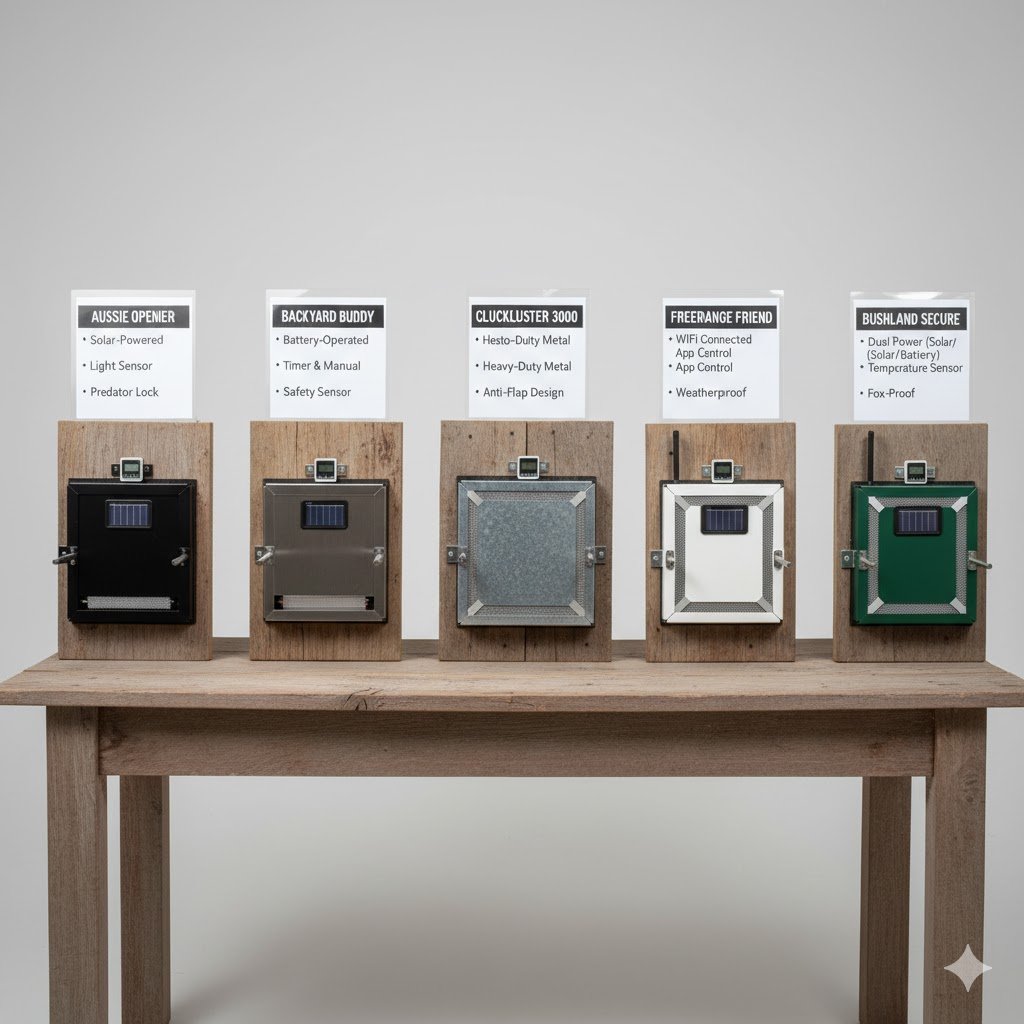
| Product | Power Source | Sensor Type | Price Range | Best For | Australian Climate Rating |
|---|---|---|---|---|---|
| PetsGear Solar | Solar + Battery | Dual (Timer & Sensor) | $$$ | Off-grid, eco-conscious | Excellent |
| Omlet | Battery | Timer & Sensor | $$ | Suburban, Omlet coop owners | Good |
| Chickcozy | Solar + Battery | Dual (Timer & Sensor) | $$ | All-round value, solar | Excellent |
| ChickenGuard | Battery | Dual (Timer & Sensor) | $$ | Customisation seekers | Good |
| Run-Chicken | Battery | Light Sensor | $ | Budget-conscious, simplicity | Good |
| Safe Coop | Battery | Dual (Timer & Sensor) | $$$ | High-predator, all-weather | Excellent |
You’ve picked out the perfect door. Now for the final step: getting it set up on your coop. Don’t worry, it’s easier than you think.
How to Install an Automatic Chicken Coop Door: Step-by-Step Guide for Australian Coops
Worried about the installation? Don’t be. If you can use a drill or a screwdriver, you can do this. It’s a great DIY weekend project, especially if you’re already in the mindset from building a chicken coop for under $200.
Tools & Materials You’ll Need
- Phillips head screwdriver (or drill)
- Spirit level
- Pencil
- Measuring tape
- Safety glasses
- Jigsaw (if you need to cut a new hole)
Measuring Your Coop: Door Opening Dimensions
First, measure your opening. As mentioned, the standard size for a chicken door is 32cm high and 25cm wide. Check the dimensions of the door you’re buying. For some, like “the auto-locking door frame will require a space 30cm wide and 63cm high” to fit the whole unit.
Preparing Your Coop Wall
You’ll need a flat, solid surface. This is also a good time to reconsider the best place to put your chicken coop for drainage and shelter. “If your coop is made of metal, you’ll need to pre-drill holes for the screws.” If you don’t have a pop-hole yet, “you’ll need to cut out a door opening in the coop for the chickens to walk through” using a jigsaw.
Attaching the Door Frame
This is the main part. “The Safe Coop automatic chicken door can simply be screwed into the coop wall using a handheld Phillips head screwdriver and the stainless steel, self-tapping screws provided.”
- Hold the door frame against the wall, over the opening.
- Use your spirit level to make sure it’s-perfectly vertical. If it’s crooked, the door will jam.
- Mark the screw holes with your pencil.
- Drill the screws in, attaching the frame securely.
Installation Tips for Different Coop Materials
- Timber: The easiest. Just screw straight in. If the wood is very old, drill small pilot holes first to prevent splitting.
- Metal: You must pre-drill pilot holes for the screws. Use the included self-tapping screws or get some from Bunnings.
- Plastic (e.g., Omlet Eglu): These often require a specific mounting kit from the manufacturer to ensure a secure, weather-proof fit. (For an idea of a specific coop assembly, see our guide to assembling an Omlet Eglu Cube).
Installing the Door Controller
If the controller is a separate box (like with ChickenGuard or Safe Coop):
- “The door controller can then be attached using the included stainless steel, self-tapping screws provided 10 cm above the top of the door rails.”
- “If the door controller is installed on a coop wall exposed to the prevailing weather, building a structure above the door controller is recommended to provide an additional layer of of protection”—a simple ‘hood’ from a piece of wood is perfect.
Next: Connecting the Cord & Testing
Follow the instructions to tie the lift-cord from the controller to the door itself. Put the batteries in and use the manual override button to test the door. Watch it go up and down 3-4 times to ensure it’s not catching or jamming.
Programming Your Automatic Door
This is the last step!
- Timer Mode: Set your desired open and times. Don’t forget to set the current time!
- Sensor Mode: Now’s the time to adjust the sensitivity. Wait until dusk and see when it closes. If it closes while your chooks are still out, adjust the setting to make it less sensitive (so it waits for darker light).
Your door is in and programmed! It’s already working for you. Here’s the simple 15-minute check-up to do every few months to make sure it runs perfectly for years.
Maintaining Your Automatic Chicken Coop Door: Tips for Long-Term Reliability
Your auto-door is a tough bit of kit, but a little maintenance goes a long way to ensure longevity. This is a simple 6-month checklist.
Your 6-Month Maintenance Checklist
- Change Batteries: Once a year (or when the ‘low battery’ light comes on), change the batteries (unless you have solar). We do this every New Year’s Day so we never forget.
- Clean Runners: This is the most important job. Every few months, wipe out the door runners/tracks. Mud, bedding, and feathers can build up and cause the door to jam.
- Clean Sensors: Give the light sensor and safety sensor (if you have one) a quick wipe with a damp cloth to remove any dust or spiderwebs.
- Clean Solar Panel: If you have a solar model, wipe the panel clean so it can get a full charge.
- Check the Cord: Once a year, check the lift-cord for any fraying or wear.
- Check Mite Prevention: While you’re at it, ensure your flock’s dust bath area is topped up and dry.
- Smell Test: A clean coop is a healthy coop. Here are some tips on how to keep a chicken coop from smelling.
- Pest Check: Look for signs of red mites, especially in wooden coops. Using diatomaceous earth for mites or learning how to get rid of red mites is crucial.
Lubrication: To Lube or Not to Lube?
A common question. Our answer: probably not. Most lubricants like oil or WD-40 will attract dust, dirt, and feathers, which will gum up the works and make jamming worse. If you feel the runners are sticking, check your manual. If you must, use a dry lubricant like graphite powder, but 99% of the time, just cleaning the runners is the right answer.
Proper maintenance will prevent most issues. But if you still have questions, we’ve got answers. Here are the most common things we get asked.
Automatic Chicken Coop Doors: Frequently Asked Questions
What is the standard for automatic doors in Australia?
There is no single “Australian Standard” for chicken coop doors. The standards you see (like AS1428) apply to human buildings. The only rules that matter are your local council regulations, which state your coop must be predator-proof.
How long do automatic chicken doors last?
A good quality door from a reputable brand should last 5-10 years. Its lifespan depends on the build quality, your climate, and basic maintenance.
How do auto chicken doors handle power outages?
Most doors run on batteries (AA, D) or have an internal rechargeable battery (solar models), so they are completely unaffected by a power outage.
What are the disadvantages of automatic doors?
The main drawbacks are the initial cost, the (minimal) maintenance required, and the reliance on technology. A cheap door can fail, which is why we recommend investing in a quality, reliable brand.
Are automatic chicken doors good?
Yes. We believe they are an essential piece of equipment for Australian backyard chicken keepers. They provide security from predators, give your flock a consistent routine, and give you incredible freedom and peace of mind.
Why use coffee grounds in chicken coops?
Used, dry coffee grounds are a great, dust-free, and eco-friendly bedding alternative. They are highly absorbent and help control odours. Just get them for free from your local cafe and dry them thoroughly in the sun.
Do you have to close the chicken coop door every night?
Yes. This is the most important step in protecting your flock from foxes, snakes, and other predators that are most active at night. An automatic door does this for you reliably, every single time.
What’s the difference between solar and battery-powered doors?
A battery-powered door runs on disposable batteries (e.g., 4xAA) that you need to replace every 6-12 months. A solar-powered door uses a small panel to charge an internal, rechargeable battery that lasts for many years, so you never have to change batteries.
Can I install an automatic door on my existing coop?
Yes. Almost all automatic doors are designed to be retro-fitted to existing coops, whether they are made of timber, metal, or plastic.
What should I do if my automatic door stops working?
First, check the batteries. Second, check for any obstructions in the door runners (mud, bedding, etc.). Third, make sure the light sensor is clean. These three steps solve 99% of all problems.
Final Verdict: Is an Automatic Chicken Door Worth It for Your Aussie Flock?
After years of testing and reviewing, our answer is a definite yes. The initial cost of a high-quality automatic chicken coop door is easily offset by the peace of mind it gives you.
Knowing your chooks are securely locked away every single night—safe from foxes and other predators—is priceless. It frees you from the daily chore, lets you have a sleep-in, and even allows you to go away for a weekend without worry.
Our final piece of advice: don’t cheap out. This is a security product. Invest in a reliable, weather-resistant model from a brand that offers a good-warranty. Your flock’s safety is worth it. We’d love to hear your experiences—let us know what door you use and how it’s handled the Aussie climate!

Oladepo Babatunde is the founder of ChickenStarter.com. He is a backyard chicken keeper and educator who specializes in helping beginners raise healthy flocks, particularly in warm climates. His expertise comes from years of hands-on experience building coops, treating common chicken ailments, and solving flock management issues. His own happy hens are a testament to his methods, laying 25-30 eggs weekly.
